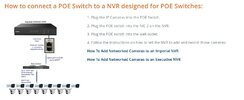Dean, all the above is good advice, but hope you haven’t been scared off by it. The loft does seem like the logical place for your main (and possibly only) switch as the cable layout for your size installation would be like a star, with the switch in the centre and cables to PC’s, cameras etc going out from it radially. This would arguably be the best for network speed and keeping the cost of cable down. However, as has been said, lofts are horrible places for man, beast and electronics and are murderously cold in winter and lethally hot in summer.
For reliability, flexibility and network security, I’d run a cable for each network device/network socket back to a central point (the switch) but avoid having the switch in the loft at all costs.
Given that you’re using CAT6, with the cable lengths I think you’re anticipating, the switch could be anywhere in your house and you’d get a good speed, unless your house is 10s of metres wide/tall.
You ask - Would the POE cameras not plug directly into the NVR? Well they could do, but it’s more elegant if you can run all the cameras to one switch if the physical geography allows. - Maybe a PoE NVR would be useful? This question is associated with what route your cables will take. I attach a picture of all the cameras in a setup going to one switch and then from that switch to the NVR. I would start looking at what kit you are considering and what the best physical cabling for it is, given its requirements/spec.
Otherwise, Just my two penn,orth throw in – in no particular order… You might also want to consider:
- Assuming you’ll be going up through a ceiling or two with your bunch of CAT6 cables, it might be worth asking your spark to make compliant provision for them. Maybe he could chase the wall and bury some 50 x 50mm or 50 x 100mm trunking in it. The spark can tell you how it will comply with regs re fire/compartmentalisation etc.
- Is your router currently in the lounge because it’s near the copper phone line installed donkeys ago? If you changed providers at some point, would the router change location because it could be where the new (fibre for instance) cable enters the house? If so, do you still want to commit to running CAT6 cables out of the lounge? Just thinking forward.
- Use 23 AWG solid copper CAT6 to avoid volt drop on long runs if there are any. FYI, I used Connectix 001-003-005-60S which apparently BT use
- As mentioned, use 2 cables per double socket for expansion/redundancy
- Think about where you have awful WiFi and if you need might need a WiFi extender/additional AP there. Run a cable for these locations
- General - If in doubt, do a run of CAT6 now, because later on it will be a MASSIVE PITA
- CAT6 really needs terminating at a socket rather than putting an RJ45 plug on it and just having it dangling out of the wall. Sockets are cheap and a breeze to use a punch down tool on.
- Think seriously about terminating all the cables back to the switch using a patch panel. I bought a CAT6 24 port Kauden one for £22.50 and a 2U box to put it in for £12.50
- If you install a patch panel make sure you leave ample metres of cable slack in case you need to move or replace the panel. I think the expression is “Service Loop” in the US. Check this out on youtube!
Given all of the above, if you’re not planning on living there a long time you could do a lash up that would be OK, but everything normally snowballs as you need to add more stuff, so you might as well be prepared for it.
I’m half way though my own installation (small 2 bed bungalow) and have just finished running the CAT6 cable. I’ve run 18 cables and used about 400M. Be prepared to use a lot of cable! It’s cheaper in a 305M box. As mentioned, it is cheap compared with the time it takes running additional runs later. One example of this is that I ran 4 x CAT6 to the TV so I can run the TV, a couple of Freeview boxes and have one spare for an Android box later on or whatever. Please keep the questions coming if you need to…


